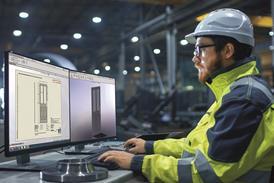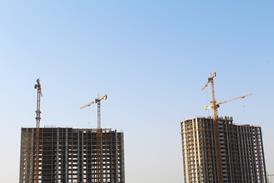In the second article in our look at health and safety issues, Rachel Clayfield examines falls from height and looks at what can be done to minimise accidents on construction sites.
Falls from height continue to be one of the most significant causes of fatal accidents in the UK. The most recent Health and Safety Executive (HSE) statistics report that 235 people were killed at work in 2003/04; 29% of these were as a result of falling from height. Falling from ladders, roofs or working platforms are the most common examples of such accidents and many other incidents arise from workers falling through roof lights, fragile roofs or from open edges.
Risk assessments
Employers have a duty to ensure the health and safety of their employees while they are at work. They must therefore take measures to ensure employees are as safe as possible when working at height. Carrying out a risk assessment is the first step to ensuring that all hazards have been considered and either eliminated or reduced as far as possible.
Consider first whether there are safer ways of doing the job that would not involve working from height. If this is not possible, don’t start the work until you have properly planned how you are going to do it and have considered all the ways in which employees could be at risk of falling. Measures must then be taken to reduce the risk as far as is reasonably practicable.
Some examples of how the risk of falling can be reduced include:
- using access towers instead of ladders;
- installing fall arrest equipment such as a safety net or harness;
- installing guard rails, toeboards and other barriers;
- providing personal suspension equipment that is securely attached and of sufficient strength;
- using crawling boards on fragile roofs;
- using working platforms that have sufficient space to enable persons to move freely.
The results of the risk assessments should be recorded in writing and discussed with the employees who will be carrying out the work. They should be kept under regular review and updated whenever necessary. Any equipment that is provided must be properly maintained and workers must be trained in its use.
The Regulations
All the above points are likely to be included in new Work at Height Regulations. These are due to be introduced as part of the HSE’s programme to reduce deaths from this type of work.
The draft regulations propose that three steps should be considered before carrying out any work at height:
- avoid the need to work at height if possible;
- where you can’t avoid working at height take steps to prevent falls;
- if there is any remaining risk of a fall, take steps to mitigate this, for example by fall arrest equipment.
The Regulations will bring together all of the current legal requirements for safe working at height. This will create a cohesive single set that will apply to any situation where work at height is carried out.
HSE inspections
For some years now the HSE has been focusing on the need to reduce falls from height. Its campaign has involved spot inspections on construction sites throughout the UK. While inspectors have found many good examples of working at height, many enforcement and prohibition notices have been served.
During one site visit contractors were found to be working on a fragile roof without any crawling boards or fall arrest equipment. They were immediately prohibited from working until appropriate safety measures had been taken. In another incident, a wooden ladder was found to be so badly damaged that the inspector immediately prohibited its use.
Working with ladders
24% of fatal and major injuries each year result from falls from ladders. It is tempting to use a ladder for all sorts of work. However, they are best used as a means of getting to a workplace rather than as the workplace itself. They should only be used as a workplace for light work or for short periods and you should always consider a working platform or a mobile scaffold tower first.
If a ladder has to be used, ensure the following steps are taken:
- the surface on which the ladder rests must be stable, level, firm and strong enough to safely support the ladder and any load placed on it;
- where the ladder is three metres or more in length, it must be secured if possible. If it cannot be secured, it should be footed by another person to prevent it slipping;
- where a ladder or a run of ladders rises a vertical distance of nine metres or more, landing areas or rest platforms must be provided at suitable intervals where practicable;
- access ladders should extend about one metre above the working platform to provide a handhold for people getting on and off them;
- the top of the ladder must rest against a solid surface, not fragile or insecure material such as plastics guttering.
Where the ladder is to be used as a workplace, consider the following:
- the work should only require one hand to be used;
- the ladder should be long enough to ensure that employees can carry out the work without stretching;
- in order to use the ladder safely, the person should be able to reach the work from a position one metre below the top of the ladder;
- make sure light tools are carried in a shoulder bag or holster attached to a belt so that both hands are free for climbing;
- heavy or bulky loads should not be carried on ladders.
Ladders should be in good condition and examined regularly for defects:
- check that none of the rungs are cracked or missing;
- do not carry out makeshift repairs to a damaged ladder;
- do not use painted ladders as the paint may hide faults;
- ladders made for DIY use are unlikely to be strong enough for site work.
A lot of these points may seem obvious, but they can be easily overlooked when the use of a ladder is just one small part of a much larger construction project. However, an unsafe or inappropriately used ladder is just as likely to cause a death as a much more complex construction activity.
Roof Work
Since any fall from a roof will inevitably involve at least a serious injury and possibly death, it is worth giving particular consideration to this type of work.
The risks are substantial, however long or short the project. It is often the case that those who are killed or seriously injured only intended to be on the roof “to have a quick look”.
If roof work cannot be avoided, in addition to the usual considerations such as edge protection and the use of fall arrest equipment, your risk assessments should cover issues such as access, training, weather and roof fragility.
It is essential to have a secure means of getting onto and off the roof. A properly secured ladder is likely to be the minimum requirement.
In terms of training, roof workers need the appropriate knowledge, skills and experience to work at height safely or they must be under the supervision of someone who has such experience. They must be able to recognise the risks and know how to operate any personal protective equipment and other items provided to them, such as harnesses and mobile access platforms.
Learning ‘on the job’ is unlikely to be sufficient where employees are working in potentially hazardous conditions. Training therefore needs to be provided before the roof work is undertaken.
All types of weather bring risks. The risks caused by ice are obvious. Wind can also be a problem, particularly if people are carrying large items such as roof sheets that can easily be caught by a gust of wind. Even the sun can be a problem if workers become faint due to excessive exposure without adequate clothing and sunscreens.
Sometimes a whole roof surface is fragile, for instance because it is in the process of construction and only the liner has been installed. In other cases, part of the roof may be fragile, for example where it contains roof lights. The fragility of a roof can often be disguised, for instance if it is being painted.
You will need to consider the condition of the roof before any work starts and, if in doubt, treat it as fragile. Ensure that platforms or other coverings are provided to support workers. In addition, properly installed safety netting beneath the roof will provide collective fall protection and individual harnesses can be used provided there are adequate attachment points.
The effects of death
The impact of a work-related death cannot be overestimated. It is a tragedy for the family and friends of the person involved and will also have a major impact on your business.
The HSE will investigate the accident. A prohibition notice may be served, which prevents you continuing with that specific activity until improvements are made. Also, the HSE could well prosecute you and/or your firm’s directors or managers for failing to ensure the health and safety of your workers.
In addition to criminal sanctions, the family of the worker involved could sue for damages. This will have a major impact on your employer’s liability premiums.
All this makes it even more important to ensure that the risks of working at height are fully considered and dealt with. More often than not, fatal accidents can be avoided by putting in place simple measures identified through a risk assessment.
Steps classes
The ECA published Practical alternatives to using stepladders in October 2004 as part of its ongoing Zero Accident Potential (ZAP) safety initiative.
This outlines the key requirements of the forthcoming Work at Height Regulations and is aimed at contractors and clients. It was produced with the support of the HSE and can be viewed on www.eca.co.uk in the health and safety section.
The HSE’s Construction information sheet 49 (revision) provides good practice guidance on the use of ladders and scaffolds. General access scaffolds and ladders outlines the selection of equipment; erection, inspection and safe use of scaffolds; plus use of ladders. This can be accessed at www.hse.gov.uk/pubns/ cis49.pdf.
The new Work at Height Regulations are expected to come into effect during 2005.
Source
Electrical and Mechanical Contractor
Postscript
Rachel Clayfield is an associate with law firm Clarks. See www.clarkslegal.com.




















No comments yet